node.js operation MongoDB instance sharing
This article mainly introduces the relevant information about the detailed examples of node.js operating MongoDB. I hope it can help everyone through instinct and let everyone understand and master this part of the content. Friends in need can refer to it. I hope it can help everyone.
When node.js operates MongoDB, you need to install the mongodb package
1. Use npm to install cnpm
npm install -g cnpm --registry=https://registry.npm.taobao.org
2. Use cnpm to install the mongodb package
cnpm install mongodb
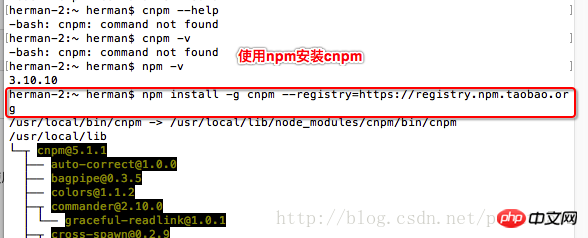
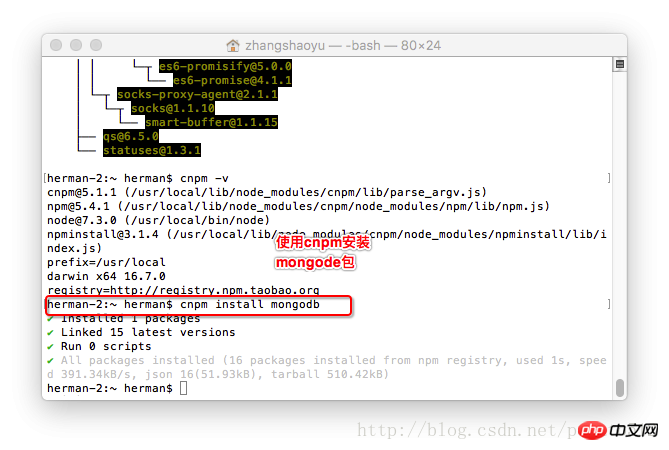
Operation stepsStep 1 Create the executable file xx.js
Step 2 The terminal calls the executable file node xx.js
Note:You need to start the server before the operation
At the same time, you need to set the operation database and operation collection
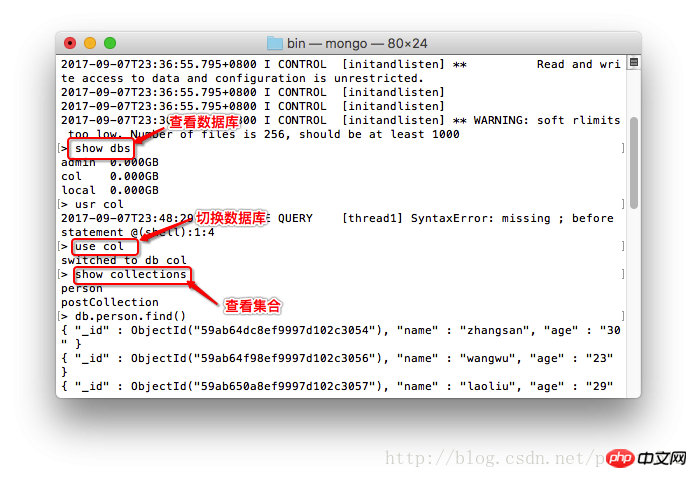
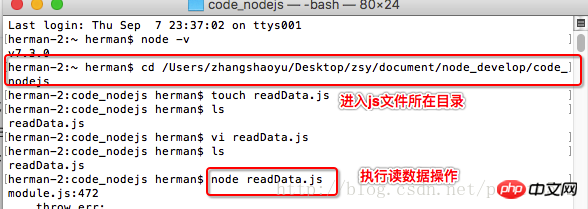
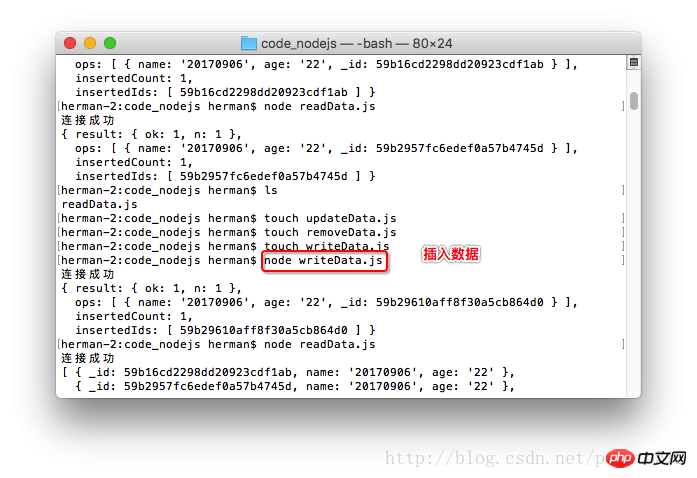


var MongoClient = require('mongodb').MongoClient;
var DB_CONN_STR = 'mongodb://localhost:27017/col';
var writeData = function(db, callback) {
// 连接到集合
var collection = db.collection('person');
// node.js operation MongoDB instance sharing
var data = [{'name':'20170906','age':'22'}];
collection.insert(data, function(error, result) {
if (error) {
console.log('error:' + error);
return;
};
callback(result);
});
}
MongoClient.connect(DB_CONN_STR, function(error, db) {
console.log('连接成功');
writeData(db, function(result) {
console.log(result);
db.close();
})
})var MongoClient = require('mongodb').MongoClient;
var DB_CONN_STR = 'mongodb://localhost:27017/col';
var updateData = function(db, callback) {
// 连接到集合
var collection = db.collection('person');
// 修改数据
var where = {'name':'20170906'};
var update = {$set:{'age':'33'}};
collection.update(where, update, function(error, result) {
if (error) {
console.log('error:' + error);
return;
};
callback(result);
});
}
MongoClient.connect(DB_CONN_STR, function(error, db) {
console.log('连接成功');
updateData(db, function(result) {
console.log(result);
db.close();
})
})var MongoClient = require('mongodb').MongoClient;
var DB_CONN_STR = 'mongodb://localhost:27017/col';
var removeData = function(db, callback) {
// 连接到集合
var collection = db.collection('person');
// node.js operation MongoDB instance sharing
var where = {'age':'22'};
collection.remove(where, function(error, result) {
if (error) {
console.log('error:' + error);
return;
};
callback(result);
});
}
MongoClient.connect(DB_CONN_STR, function(error, db) {
console.log('连接成功');
removeData(db, function(result) {
console.log(result);
db.close();
})
})
var MongoClient = require('mongodb').MongoClient;
var DB_CONN_STR = 'mongodb://localhost:27017/col';
var readData = function(db, callback) {
// 连接到集合
var collection = db.collection('person');
// 查询数据
var where = {'name':'20170906'};
collection.find(where).toArray(function(error, result) {
if (error)
{
console.log('error:' + error);
return;
};
callback(result);
});
}
MongoClient.connect(DB_CONN_STR, function(error, db) {
console.log('连接成功');
readData(db, function(result) {
console.log(result);
db.close();
})
})tp5 operates mongoDB database instance
MongoDB singleton mode instance operation sharing implemented by php
Completely master the add, delete, modify and query functions of nodejs to operate mongodb
The above is the detailed content of node.js operation MongoDB instance sharing. For more information, please follow other related articles on the PHP Chinese website!

Hot AI Tools

Undresser.AI Undress
AI-powered app for creating realistic nude photos

AI Clothes Remover
Online AI tool for removing clothes from photos.

Undress AI Tool
Undress images for free

Clothoff.io
AI clothes remover

Video Face Swap
Swap faces in any video effortlessly with our completely free AI face swap tool!

Hot Article

Hot Tools

Notepad++7.3.1
Easy-to-use and free code editor

SublimeText3 Chinese version
Chinese version, very easy to use

Zend Studio 13.0.1
Powerful PHP integrated development environment

Dreamweaver CS6
Visual web development tools

SublimeText3 Mac version
God-level code editing software (SublimeText3)

Hot Topics
 What is the use of net4.0
May 10, 2024 am 01:09 AM
What is the use of net4.0
May 10, 2024 am 01:09 AM
.NET 4.0 is used to create a variety of applications and it provides application developers with rich features including: object-oriented programming, flexibility, powerful architecture, cloud computing integration, performance optimization, extensive libraries, security, Scalability, data access, and mobile development support.
 Comparison of Golang and Node.js in backend development
Jun 03, 2024 pm 02:31 PM
Comparison of Golang and Node.js in backend development
Jun 03, 2024 pm 02:31 PM
Go and Node.js have differences in typing (strong/weak), concurrency (goroutine/event loop), and garbage collection (automatic/manual). Go has high throughput and low latency, and is suitable for high-load backends; Node.js is good at asynchronous I/O and is suitable for high concurrency and short requests. Practical cases of the two include Kubernetes (Go), database connection (Node.js), and web applications (Go/Node.js). The final choice depends on application needs, team skills, and personal preference.
 How to configure MongoDB automatic expansion on Debian
Apr 02, 2025 am 07:36 AM
How to configure MongoDB automatic expansion on Debian
Apr 02, 2025 am 07:36 AM
This article introduces how to configure MongoDB on Debian system to achieve automatic expansion. The main steps include setting up the MongoDB replica set and disk space monitoring. 1. MongoDB installation First, make sure that MongoDB is installed on the Debian system. Install using the following command: sudoaptupdatesudoaptinstall-ymongodb-org 2. Configuring MongoDB replica set MongoDB replica set ensures high availability and data redundancy, which is the basis for achieving automatic capacity expansion. Start MongoDB service: sudosystemctlstartmongodsudosys
 How to ensure high availability of MongoDB on Debian
Apr 02, 2025 am 07:21 AM
How to ensure high availability of MongoDB on Debian
Apr 02, 2025 am 07:21 AM
This article describes how to build a highly available MongoDB database on a Debian system. We will explore multiple ways to ensure data security and services continue to operate. Key strategy: ReplicaSet: ReplicaSet: Use replicasets to achieve data redundancy and automatic failover. When a master node fails, the replica set will automatically elect a new master node to ensure the continuous availability of the service. Data backup and recovery: Regularly use the mongodump command to backup the database and formulate effective recovery strategies to deal with the risk of data loss. Monitoring and Alarms: Deploy monitoring tools (such as Prometheus, Grafana) to monitor the running status of MongoDB in real time, and
 Navicat's method to view MongoDB database password
Apr 08, 2025 pm 09:39 PM
Navicat's method to view MongoDB database password
Apr 08, 2025 pm 09:39 PM
It is impossible to view MongoDB password directly through Navicat because it is stored as hash values. How to retrieve lost passwords: 1. Reset passwords; 2. Check configuration files (may contain hash values); 3. Check codes (may hardcode passwords).
 Use Composer to solve the dilemma of recommendation systems: andres-montanez/recommendations-bundle
Apr 18, 2025 am 11:48 AM
Use Composer to solve the dilemma of recommendation systems: andres-montanez/recommendations-bundle
Apr 18, 2025 am 11:48 AM
When developing an e-commerce website, I encountered a difficult problem: how to provide users with personalized product recommendations. Initially, I tried some simple recommendation algorithms, but the results were not ideal, and user satisfaction was also affected. In order to improve the accuracy and efficiency of the recommendation system, I decided to adopt a more professional solution. Finally, I installed andres-montanez/recommendations-bundle through Composer, which not only solved my problem, but also greatly improved the performance of the recommendation system. You can learn composer through the following address:
 What is the CentOS MongoDB backup strategy?
Apr 14, 2025 pm 04:51 PM
What is the CentOS MongoDB backup strategy?
Apr 14, 2025 pm 04:51 PM
Detailed explanation of MongoDB efficient backup strategy under CentOS system This article will introduce in detail the various strategies for implementing MongoDB backup on CentOS system to ensure data security and business continuity. We will cover manual backups, timed backups, automated script backups, and backup methods in Docker container environments, and provide best practices for backup file management. Manual backup: Use the mongodump command to perform manual full backup, for example: mongodump-hlocalhost:27017-u username-p password-d database name-o/backup directory This command will export the data and metadata of the specified database to the specified backup directory.
 MongoDB and relational database: a comprehensive comparison
Apr 08, 2025 pm 06:30 PM
MongoDB and relational database: a comprehensive comparison
Apr 08, 2025 pm 06:30 PM
MongoDB and relational database: In-depth comparison This article will explore in-depth the differences between NoSQL database MongoDB and traditional relational databases (such as MySQL and SQLServer). Relational databases use table structures of rows and columns to organize data, while MongoDB uses flexible document-oriented models to better suit the needs of modern applications. Mainly differentiates data structures: Relational databases use predefined schema tables to store data, and relationships between tables are established through primary keys and foreign keys; MongoDB uses JSON-like BSON documents to store them in a collection, and each document structure can be independently changed to achieve pattern-free design. Architectural design: Relational databases need to pre-defined fixed schema; MongoDB supports






